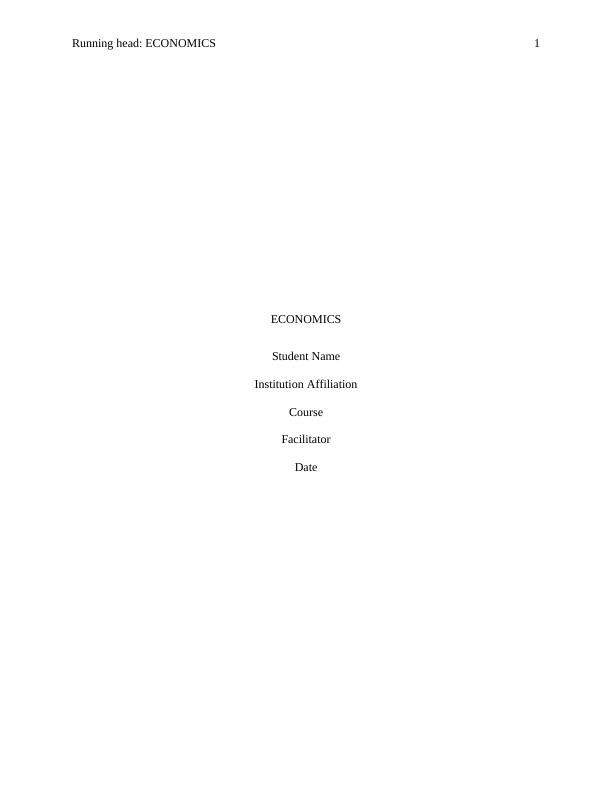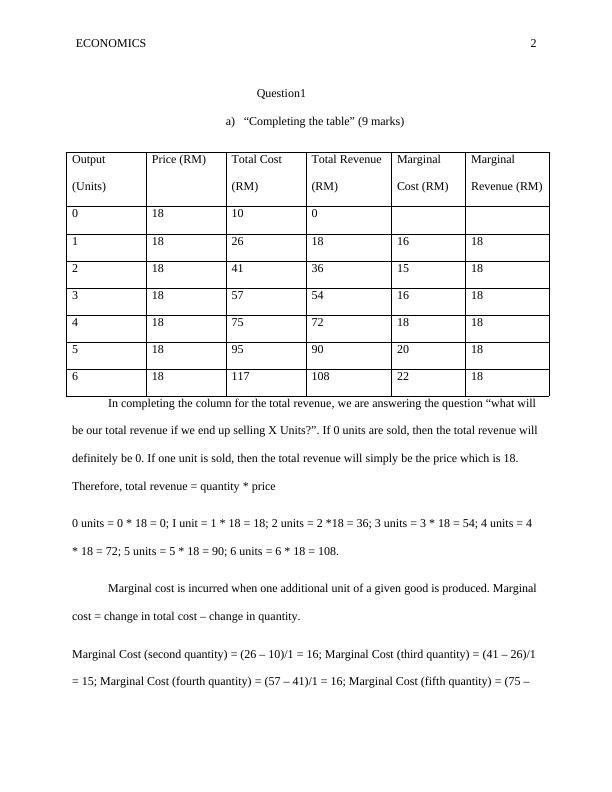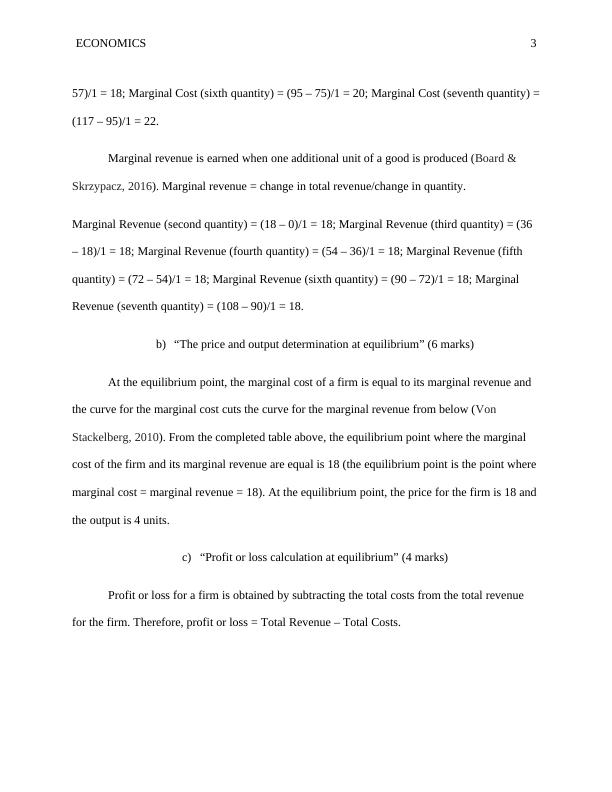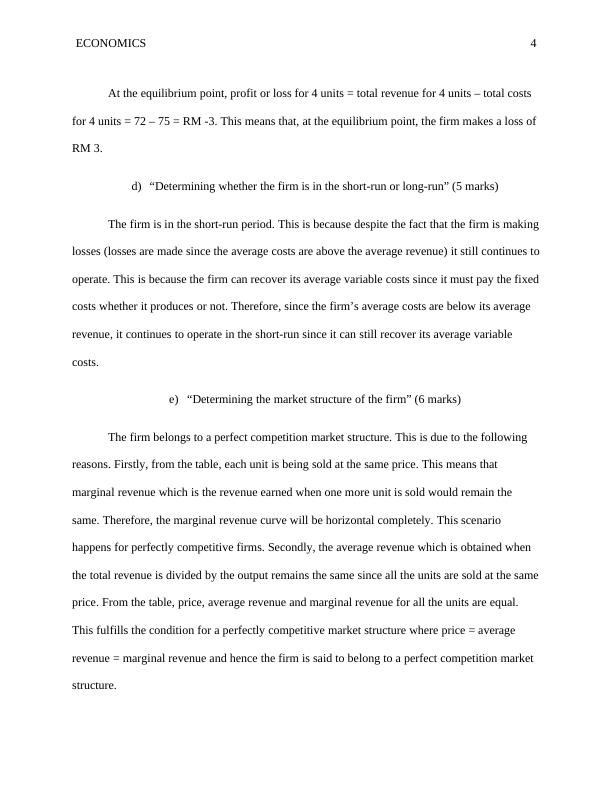Completing the Table: Economics
Added on 2022-11-25
12 Pages2541 Words297 Views
Running head: ECONOMICS 1
ECONOMICS
Student Name
Institution Affiliation
Course
Facilitator
Date
ECONOMICS
Student Name
Institution Affiliation
Course
Facilitator
Date

ECONOMICS 2
Question1
a) “Completing the table” (9 marks)
Output
(Units)
Price (RM) Total Cost
(RM)
Total Revenue
(RM)
Marginal
Cost (RM)
Marginal
Revenue (RM)
0 18 10 0
1 18 26 18 16 18
2 18 41 36 15 18
3 18 57 54 16 18
4 18 75 72 18 18
5 18 95 90 20 18
6 18 117 108 22 18
In completing the column for the total revenue, we are answering the question “what will
be our total revenue if we end up selling X Units?”. If 0 units are sold, then the total revenue will
definitely be 0. If one unit is sold, then the total revenue will simply be the price which is 18.
Therefore, total revenue = quantity * price
0 units = 0 * 18 = 0; I unit = 1 * 18 = 18; 2 units = 2 *18 = 36; 3 units = 3 * 18 = 54; 4 units = 4
* 18 = 72; 5 units = 5 * 18 = 90; 6 units = 6 * 18 = 108.
Marginal cost is incurred when one additional unit of a given good is produced. Marginal
cost = change in total cost – change in quantity.
Marginal Cost (second quantity) = (26 – 10)/1 = 16; Marginal Cost (third quantity) = (41 – 26)/1
= 15; Marginal Cost (fourth quantity) = (57 – 41)/1 = 16; Marginal Cost (fifth quantity) = (75 –
Question1
a) “Completing the table” (9 marks)
Output
(Units)
Price (RM) Total Cost
(RM)
Total Revenue
(RM)
Marginal
Cost (RM)
Marginal
Revenue (RM)
0 18 10 0
1 18 26 18 16 18
2 18 41 36 15 18
3 18 57 54 16 18
4 18 75 72 18 18
5 18 95 90 20 18
6 18 117 108 22 18
In completing the column for the total revenue, we are answering the question “what will
be our total revenue if we end up selling X Units?”. If 0 units are sold, then the total revenue will
definitely be 0. If one unit is sold, then the total revenue will simply be the price which is 18.
Therefore, total revenue = quantity * price
0 units = 0 * 18 = 0; I unit = 1 * 18 = 18; 2 units = 2 *18 = 36; 3 units = 3 * 18 = 54; 4 units = 4
* 18 = 72; 5 units = 5 * 18 = 90; 6 units = 6 * 18 = 108.
Marginal cost is incurred when one additional unit of a given good is produced. Marginal
cost = change in total cost – change in quantity.
Marginal Cost (second quantity) = (26 – 10)/1 = 16; Marginal Cost (third quantity) = (41 – 26)/1
= 15; Marginal Cost (fourth quantity) = (57 – 41)/1 = 16; Marginal Cost (fifth quantity) = (75 –

ECONOMICS 3
57)/1 = 18; Marginal Cost (sixth quantity) = (95 – 75)/1 = 20; Marginal Cost (seventh quantity) =
(117 – 95)/1 = 22.
Marginal revenue is earned when one additional unit of a good is produced (Board &
Skrzypacz, 2016). Marginal revenue = change in total revenue/change in quantity.
Marginal Revenue (second quantity) = (18 – 0)/1 = 18; Marginal Revenue (third quantity) = (36
– 18)/1 = 18; Marginal Revenue (fourth quantity) = (54 – 36)/1 = 18; Marginal Revenue (fifth
quantity) = (72 – 54)/1 = 18; Marginal Revenue (sixth quantity) = (90 – 72)/1 = 18; Marginal
Revenue (seventh quantity) = (108 – 90)/1 = 18.
b) “The price and output determination at equilibrium” (6 marks)
At the equilibrium point, the marginal cost of a firm is equal to its marginal revenue and
the curve for the marginal cost cuts the curve for the marginal revenue from below (Von
Stackelberg, 2010). From the completed table above, the equilibrium point where the marginal
cost of the firm and its marginal revenue are equal is 18 (the equilibrium point is the point where
marginal cost = marginal revenue = 18). At the equilibrium point, the price for the firm is 18 and
the output is 4 units.
c) “Profit or loss calculation at equilibrium” (4 marks)
Profit or loss for a firm is obtained by subtracting the total costs from the total revenue
for the firm. Therefore, profit or loss = Total Revenue – Total Costs.
57)/1 = 18; Marginal Cost (sixth quantity) = (95 – 75)/1 = 20; Marginal Cost (seventh quantity) =
(117 – 95)/1 = 22.
Marginal revenue is earned when one additional unit of a good is produced (Board &
Skrzypacz, 2016). Marginal revenue = change in total revenue/change in quantity.
Marginal Revenue (second quantity) = (18 – 0)/1 = 18; Marginal Revenue (third quantity) = (36
– 18)/1 = 18; Marginal Revenue (fourth quantity) = (54 – 36)/1 = 18; Marginal Revenue (fifth
quantity) = (72 – 54)/1 = 18; Marginal Revenue (sixth quantity) = (90 – 72)/1 = 18; Marginal
Revenue (seventh quantity) = (108 – 90)/1 = 18.
b) “The price and output determination at equilibrium” (6 marks)
At the equilibrium point, the marginal cost of a firm is equal to its marginal revenue and
the curve for the marginal cost cuts the curve for the marginal revenue from below (Von
Stackelberg, 2010). From the completed table above, the equilibrium point where the marginal
cost of the firm and its marginal revenue are equal is 18 (the equilibrium point is the point where
marginal cost = marginal revenue = 18). At the equilibrium point, the price for the firm is 18 and
the output is 4 units.
c) “Profit or loss calculation at equilibrium” (4 marks)
Profit or loss for a firm is obtained by subtracting the total costs from the total revenue
for the firm. Therefore, profit or loss = Total Revenue – Total Costs.

ECONOMICS 4
At the equilibrium point, profit or loss for 4 units = total revenue for 4 units – total costs
for 4 units = 72 – 75 = RM -3. This means that, at the equilibrium point, the firm makes a loss of
RM 3.
d) “Determining whether the firm is in the short-run or long-run” (5 marks)
The firm is in the short-run period. This is because despite the fact that the firm is making
losses (losses are made since the average costs are above the average revenue) it still continues to
operate. This is because the firm can recover its average variable costs since it must pay the fixed
costs whether it produces or not. Therefore, since the firm’s average costs are below its average
revenue, it continues to operate in the short-run since it can still recover its average variable
costs.
e) “Determining the market structure of the firm” (6 marks)
The firm belongs to a perfect competition market structure. This is due to the following
reasons. Firstly, from the table, each unit is being sold at the same price. This means that
marginal revenue which is the revenue earned when one more unit is sold would remain the
same. Therefore, the marginal revenue curve will be horizontal completely. This scenario
happens for perfectly competitive firms. Secondly, the average revenue which is obtained when
the total revenue is divided by the output remains the same since all the units are sold at the same
price. From the table, price, average revenue and marginal revenue for all the units are equal.
This fulfills the condition for a perfectly competitive market structure where price = average
revenue = marginal revenue and hence the firm is said to belong to a perfect competition market
structure.
At the equilibrium point, profit or loss for 4 units = total revenue for 4 units – total costs
for 4 units = 72 – 75 = RM -3. This means that, at the equilibrium point, the firm makes a loss of
RM 3.
d) “Determining whether the firm is in the short-run or long-run” (5 marks)
The firm is in the short-run period. This is because despite the fact that the firm is making
losses (losses are made since the average costs are above the average revenue) it still continues to
operate. This is because the firm can recover its average variable costs since it must pay the fixed
costs whether it produces or not. Therefore, since the firm’s average costs are below its average
revenue, it continues to operate in the short-run since it can still recover its average variable
costs.
e) “Determining the market structure of the firm” (6 marks)
The firm belongs to a perfect competition market structure. This is due to the following
reasons. Firstly, from the table, each unit is being sold at the same price. This means that
marginal revenue which is the revenue earned when one more unit is sold would remain the
same. Therefore, the marginal revenue curve will be horizontal completely. This scenario
happens for perfectly competitive firms. Secondly, the average revenue which is obtained when
the total revenue is divided by the output remains the same since all the units are sold at the same
price. From the table, price, average revenue and marginal revenue for all the units are equal.
This fulfills the condition for a perfectly competitive market structure where price = average
revenue = marginal revenue and hence the firm is said to belong to a perfect competition market
structure.

End of preview
Want to access all the pages? Upload your documents or become a member.
Related Documents
Methods of Sampling and Data Collection in Statisticslg...
|5
|758
|214
Economics Assignment Questions and Answerslg...
|5
|619
|140
Understanding Exponential Decay through Newton's Law of Coolinglg...
|9
|783
|478
Management Accounting Quiz and Assignmentslg...
|11
|1436
|405
R Programming Examples for Beginnerslg...
|5
|2772
|55
Desklib - Online Library for Study Materiallg...
|11
|2075
|276
